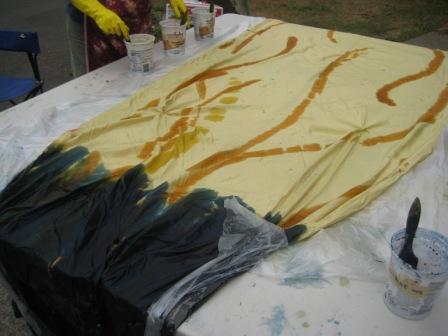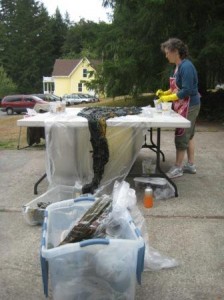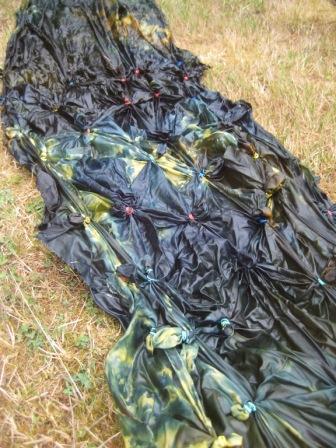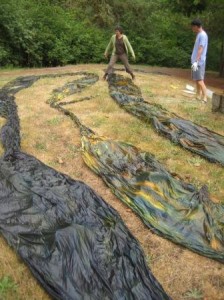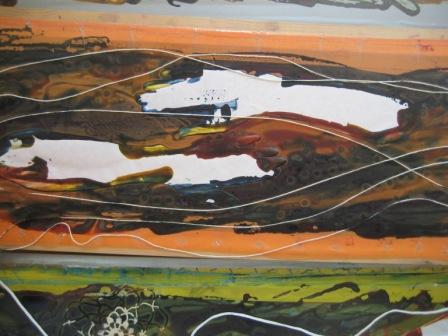
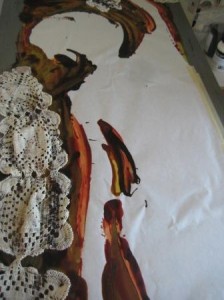 I was invited to be a part of MadArt, a window art project in Madison Park that opened on September 13th. The project matched artists with local businesses to install art in their windows for three weeks. I asked to be matched with Ann Marie Lingerie, a store that sells high end lingerie, because the body of work I visualized was about the figure, women’s roles, and working with form and transparency.
I was invited to be a part of MadArt, a window art project in Madison Park that opened on September 13th. The project matched artists with local businesses to install art in their windows for three weeks. I asked to be matched with Ann Marie Lingerie, a store that sells high end lingerie, because the body of work I visualized was about the figure, women’s roles, and working with form and transparency.
I was partially inspired for this body of work by obtaining three large-scale, used silk screens from the estate sale of Su Job, a local fiber artist and friend who died of cancer this year. I’d also been wanting to push the limits of how large I could go with my 3-d fiber forms.
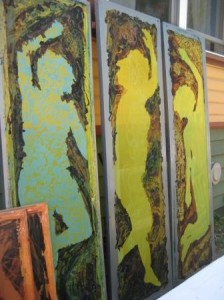 I used the technique of break down printing along with my own twist, using freezer paper as a resist for the image area. This technique gave me the soft and abstracted imagery I was looking for. In working with the female form, I used the most convenient model around, myself. I turned photos into silhouettes which I attached temporarily to the silk screens. I wanted to add more texture to the screens and, looking around the studio, was thrilled to find my stash of doilies. Just the thing to add texture and keep the theme of women’s work and roles.
I used the technique of break down printing along with my own twist, using freezer paper as a resist for the image area. This technique gave me the soft and abstracted imagery I was looking for. In working with the female form, I used the most convenient model around, myself. I turned photos into silhouettes which I attached temporarily to the silk screens. I wanted to add more texture to the screens and, looking around the studio, was thrilled to find my stash of doilies. Just the thing to add texture and keep the theme of women’s work and roles.
Next hurdle, space to print. I can’t fit an eight foot print space in my studio. So I printed the fabrics outdoors on improvised tables with the help of my studio-mate Pam on a beautiful June day. When we started printing I was surprised to find that, even though I had cleaned the screens of Su’s imagery before starting, her patterns were ghosting through. At first I was upset because I hadn’t planned on that element, but once I relaxed I found that her work added immensely to the texture and density of the designs. I like to think of the fabric as a unintended collaboration with a woman whose work I admired and respected.
Once the fabrics were printed and my installation space was finalized I was able to design the installation and start work on the forms. I designed and worked on the forms using my usual technique (see previous blog post). The challenge was just how big could I go without using additional support. Well, the largest form was my size (approx. 61 inches tall) and was self-supporting. I did end up using some fiberfill stuffing in the bottom of it to help it hold its form.
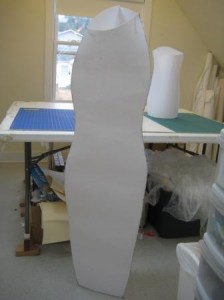
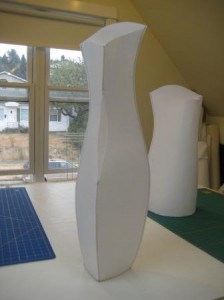
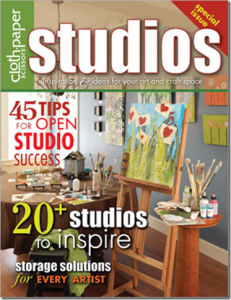 I’m participating in Quilting Arts Magazine’s virtual Open Studio. Click on the link below to reach the website of Studios Magazine. And check back in the next few days to see pictures from my studios.
I’m participating in Quilting Arts Magazine’s virtual Open Studio. Click on the link below to reach the website of Studios Magazine. And check back in the next few days to see pictures from my studios.
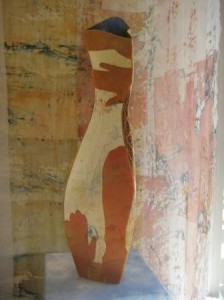
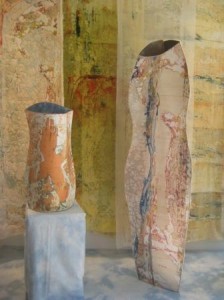
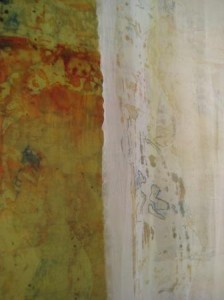
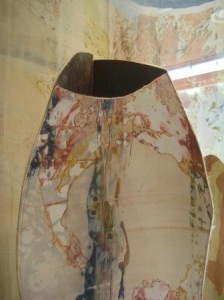

 I was invited to be a part of MadArt, a window art project in Madison Park that opened on September 13th. The project matched artists with local businesses to install art in their windows for three weeks. I asked to be matched with Ann Marie Lingerie, a store that sells high end lingerie, because the body of work I visualized was about the figure, women’s roles, and working with form and transparency.
I was invited to be a part of MadArt, a window art project in Madison Park that opened on September 13th. The project matched artists with local businesses to install art in their windows for three weeks. I asked to be matched with Ann Marie Lingerie, a store that sells high end lingerie, because the body of work I visualized was about the figure, women’s roles, and working with form and transparency. I used the technique of break down printing along with my own twist, using freezer paper as a resist for the image area. This technique gave me the soft and abstracted imagery I was looking for. In working with the female form, I used the most convenient model around, myself. I turned photos into silhouettes which I attached temporarily to the silk screens. I wanted to add more texture to the screens and, looking around the studio, was thrilled to find my stash of doilies. Just the thing to add texture and keep the theme of women’s work and roles.
I used the technique of break down printing along with my own twist, using freezer paper as a resist for the image area. This technique gave me the soft and abstracted imagery I was looking for. In working with the female form, I used the most convenient model around, myself. I turned photos into silhouettes which I attached temporarily to the silk screens. I wanted to add more texture to the screens and, looking around the studio, was thrilled to find my stash of doilies. Just the thing to add texture and keep the theme of women’s work and roles.

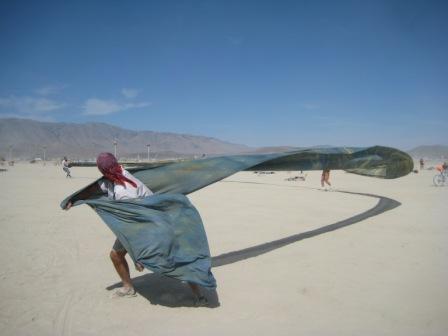 This year was my third trip to Burning Man, the alternative arts festival in the Black Rock Desert of Nevada. One of the precepts of the event is that there are “no spectators” and I’ve wanted to bring some of my work to share. It is a challenging environment for fiber art, very dusty and windy. My previous attempts to bring my work there have been foiled by the strong winds.
This year was my third trip to Burning Man, the alternative arts festival in the Black Rock Desert of Nevada. One of the precepts of the event is that there are “no spectators” and I’ve wanted to bring some of my work to share. It is a challenging environment for fiber art, very dusty and windy. My previous attempts to bring my work there have been foiled by the strong winds.
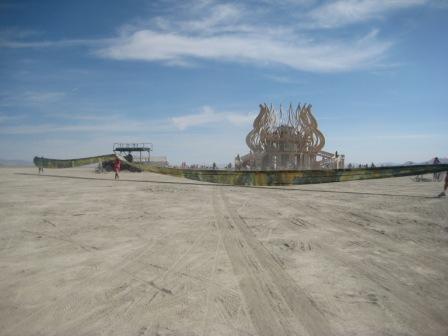
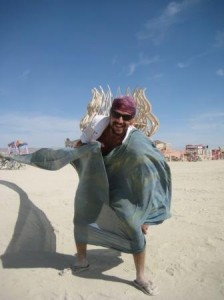
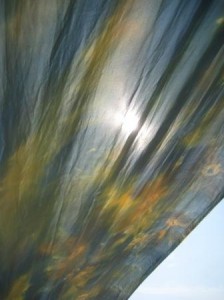
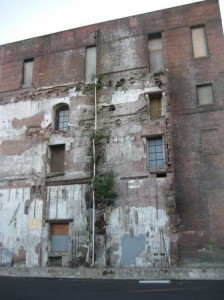 I love my Canon PowerShot SD 1000 because it takes pretty good photos for a point and shoot and it’s small and sturdy enough to keep in my purse. I got these shots on a family trip to the Georgetown neighborhood of Seattle. The light was right when we came upon these distressed walls. I think they make really interesting abstract compositions. Who knows when or if they’ll show up in my work.
I love my Canon PowerShot SD 1000 because it takes pretty good photos for a point and shoot and it’s small and sturdy enough to keep in my purse. I got these shots on a family trip to the Georgetown neighborhood of Seattle. The light was right when we came upon these distressed walls. I think they make really interesting abstract compositions. Who knows when or if they’ll show up in my work.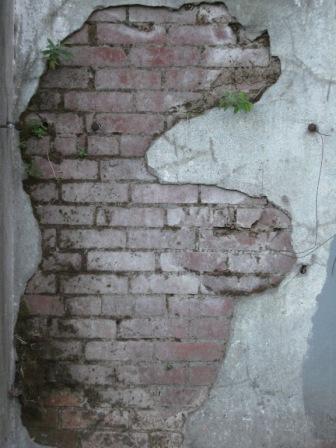
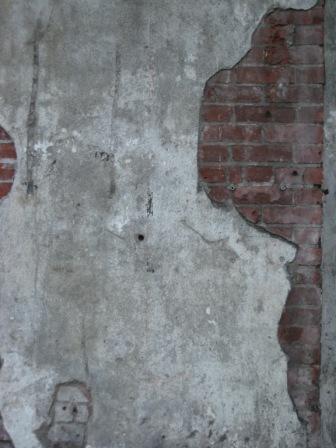
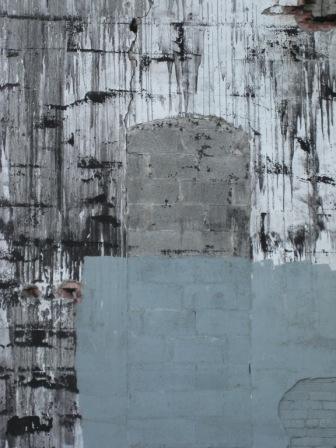
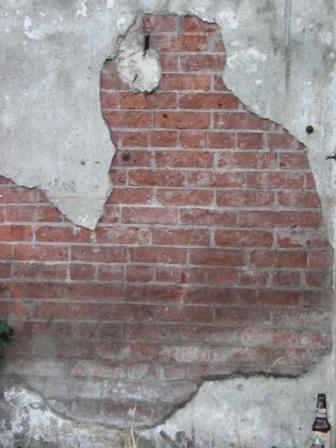
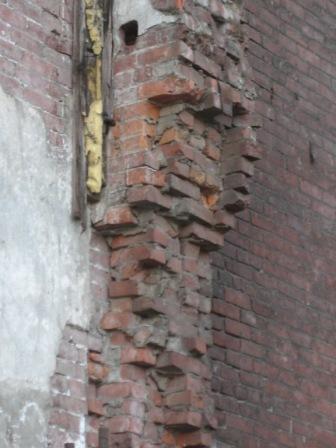
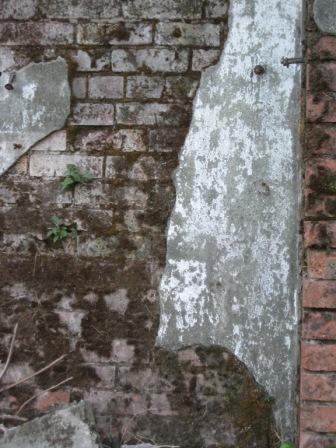
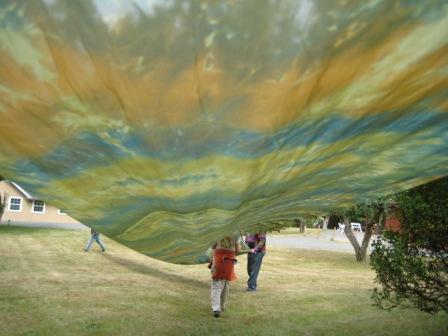 Once the looong piece of fabric was washed and dried we had a great time playing with it. Here are some photos.
Once the looong piece of fabric was washed and dried we had a great time playing with it. Here are some photos.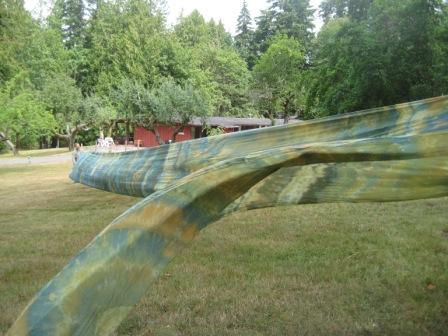
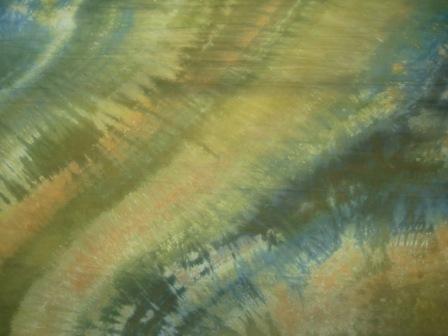
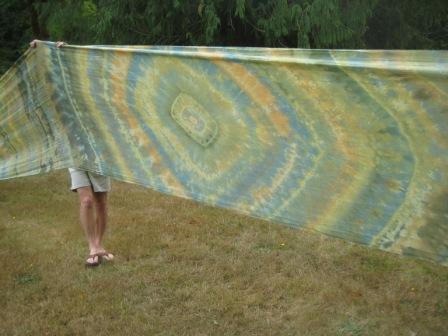
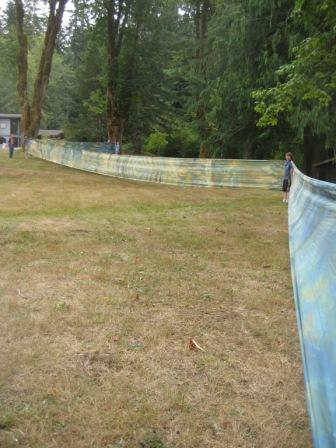
 I dyed one very long piece of fabric this Summer, 150 feet to be exact, one 50 yard bolt of silk habotai. My plan was to bring it to Burning Man where this year’s theme was Evolution. I wanted to create something that had a narrative, even if very abstract, but there were challenges in the process. One challenge was simply time, I had just a few days to fit in the project as I spent my Summer either out of town or working on my pieces for the MadArt exhibition. Although I would have like to use soy wax batik to add pictoral and linear elements, I just couldn’t figure out just how I was going to remove the wax out of that much fabric within my time frame. Our final solution was to use multiple shibori techniques and gradation of color over the length of the fabric. With my husband as an assistant, we bound and dyed the fabric one day, batched it overnight, and washed it out the next day.
I dyed one very long piece of fabric this Summer, 150 feet to be exact, one 50 yard bolt of silk habotai. My plan was to bring it to Burning Man where this year’s theme was Evolution. I wanted to create something that had a narrative, even if very abstract, but there were challenges in the process. One challenge was simply time, I had just a few days to fit in the project as I spent my Summer either out of town or working on my pieces for the MadArt exhibition. Although I would have like to use soy wax batik to add pictoral and linear elements, I just couldn’t figure out just how I was going to remove the wax out of that much fabric within my time frame. Our final solution was to use multiple shibori techniques and gradation of color over the length of the fabric. With my husband as an assistant, we bound and dyed the fabric one day, batched it overnight, and washed it out the next day.